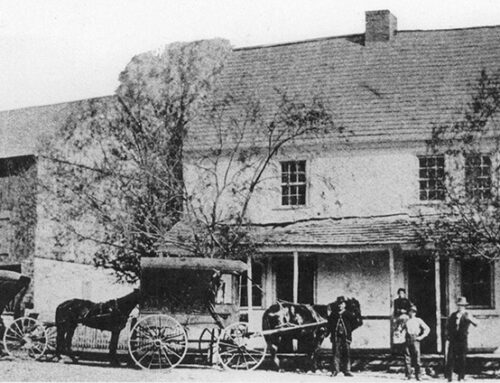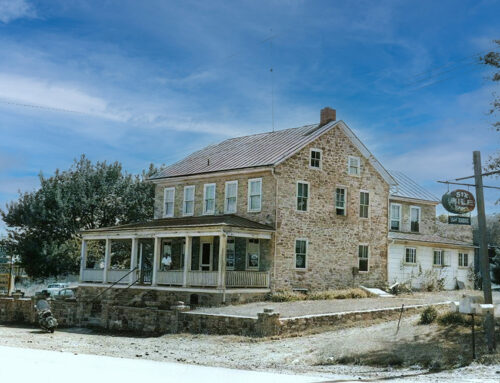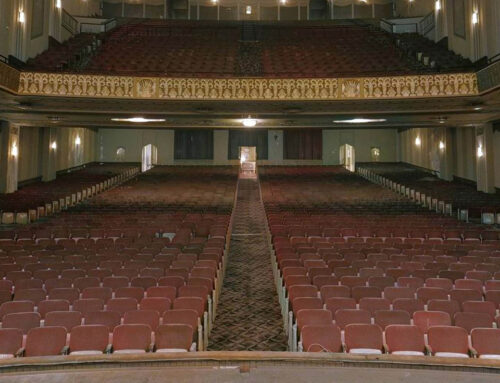The Gruber Wagon Works, recognized as a National Historic Landmark, exists as one of the finest examples of late nineteenth century manufacturing in the United States. The wagon works, which contains over 19,000 artifacts and depicts the business peak production years of the early 1900s is located at the Berks County Heritage Center in Bern Township, Pennsylvania.
Below: Gruber Wagon Works, Mt. Pleasant – Touch or Click Image to Enlarge.
In 1882 Franklin H. Gruber, German-Swiss immigrant, moved his wagon building operation from his farm to a site just south of Mt. Pleasant (Obold) along the Licking Creek. The manufacturing process at the wagon works evolved from a single craftsman using a technique and tools that had been handed down through the generations, to a family operated business employing mass production techniques.
Although Franklin started the wagon works, it was his sons (George, Adam, John, Jacob) who continually sought ways to improve their methods of production. The Grubers not only bought machinery to do this, but they also designed their own machines for specialized operations. Farm wagons, hayflats, wheelbarrows, work sleighs, wooden truck bodies and specialty wagons were all built to customer specifications at the wagon works.
Wagon production peaked in the 1920s when the Grubers employed over 20 men six days a week and built over 100 wagons a year. The popularity of the automobile caused a decline in wagon building. The Grubers then turned to wooden truck bodies and socket wrenches as a supplement to building and repairing wagons. The factory still turned out wagons in the 1950s for Amish farmers, and the shops were used occasionally for small jobs and repairs until its doors closed in 1972.
The United States Army Corps of Engineers began construction of Blue Marsh Lake, northwest of Reading, in March 1974. The main purpose of Blue Marsh is to provide flood control to part of the Schuylkill River Valley. Initial authorization for the lake was granted by the Flood Control Act of 1962.

During construction of Blue Marsh Lake an issue arose with regard to a historic facility known as Gruber Wagon Works, located in the area that would be flooded when Blue Marsh Reservoir filled.
Eighty-six tons of American industrial history was relocated during December 1976 to save the Gruber Wagon Works. The wagon works was located in the flood pool area of the Blue Marsh lake reservoir, a $43 million flood control, water supply and recreation project of the Philadelphia district, US Army corps of engineers.
In 1966, Congress had passed the National Historic Preservation Act (NHPA), which contained a section (Section 106) that required the heads of any federal or federally assisted project to “take into account” the effects of undertakings “on any District, site, building, structure, or object that is included in or eligible for inclusion in the National Register” – a list of all “districts, sites, buildings, structures, and objects significant in American history, architecture, archaeology, engineering, and culture.” This provision meant that whenever the Corps began an undertaking, it had to determine what prehistoric or historic resources would be affected and consult with state historic preservation offices and the Advisory Council on Historic Preservation on how to avoid or mitigate the consequences on those resources.
Before the passage of the NHPA, Temple University had completed an archeological survey of the Blue Marsh Dam site and had concluded in 1965 “that the area contained no sites of national significance,” perhaps because it focused only on archeological resources and not on above-ground structures. When the Philadelphia District began its real estate appraisal work in 1970, it discovered the Gruber Wagon Works, a three-level frame building on the east bank of Licking Creek that had existed “totally intact” from the “time where its physical development had virtually stopped some fifty years before.”
Recognizing the potential significance of this structure, the district requested that the Pennsylvania Historical and Museum Commission and the Northeast Regional Office of the National Park Service (NPS) examine the structure. This occurred in July 1970.
The first floor of the building contained the complete shop for the manufacture of wagons and wagon bodies including a forge. The wagon works was in excellent condition; all of its machinery, equipment, hand tools, forge and carpentry shop were well maintained. The entire plant was in operating condition. The second floor had small machine tools and also contained the various parts and slopes for the construction of the wagons. There were several small farm wagons complete with the Gruber name and design as well as hay wagons, and wagons of other types apparently held for exhibit purposes. An elevator, hand or horse operated large enough for a long wagon was available to carry materials from the 1st to 2nd floors. The third floor or loft level was mainly used for storage of materials.

Hand tools, and carpentry shop were well maintained.
The shop’s original machinery had been replaced in the early twentieth century; since then, it had essentially remained intact. Because of the historic significance of the wagon works, according to Murray H. Nelligan, NPS Landmark and National Register specialist, all parties agreed “that efforts should be made to salvage the building and its contents by moving it to an appropriate spot in the projected state park, where it would be outside the reservoir area, and that each agency would explore possibilities for accomplishing this.”
Accordingly, the Philadelphia District began working with the NPS Historic American Engineering Record to document the structure and its contents “so that it could be reconstructed in a protected area.”
The problem was that neither the NPS nor the Commonwealth of Pennsylvania had the funding to move the works. The Corps, meanwhile, could pay for the “costs associated with purchase of the real property, transportation of the new structure to a new location, and provision of a foundation at the new site” but did not have authority to expend funds for “dismantlement and reassembly of the structure and purchase of historically significant personal property within the building.” The need to preserve the building became even more important after the Advisory Council on Historic Preservation placed the wagon works on the National Register of Historic Places on 2 June 1972. In November 1973, the Philadelphia District requested “the authority to expend funds necessary to relocate the building, complete with its contents, to a site on Government owned land,” and the district began working with Congress to get the legislation passed. It also consulted with Berks County and agreed to relocate the shop to a county park, where the county would assume operation and maintenance of the site. The Corps found the money in 1974 to purchase the wagon works, as well as its equipment and furnishings, although it still did not have the money to relocate the structure.
In May 1974, Congress passed the Archeological and Historic Preservation Act (known as the Moss-Bennett Act), permitting federal agencies to spend up to 1 percent of project funding to recover historic and archeological resources. This meant that the Philadelphia District could spend approximately $430,000 to relocate the Gruber Wagon Works (1 percent of the estimated $43 million price tag of Blue Marsh Dam); however, officials estimated that it would cost $922,000 “to relocate and restore the original structure and its equipment.” With strong grass-roots support, Congress debated two bills in April 1975 that would provide funding to the Corps for the Gruber Wagon Works. These bills authorized the Corps “to relocate and restore intact the historic structure and associated improvements known as the Gruber Wagon Works” and provided appropriations “as may be necessary” for that to occur.
Congress eventually included the text of the bills in the Water Resources Development Act of 1976, which it passed on 1 October 1976 and which President Gerald Ford signed on 22 October 1976. The act authorized the Corps to relocate and restore the wagon works “at an estimated cost of $922,000.” After the Corps had effectuated the transfer, the legislation directed the Corps to transfer “title to the structure and associated improvements to the County of Berks upon condition that such county agree to maintain such historic property in perpetuity as a public museum at no cost to the Federal Government.”
With this funding and authorization, the Philadelphia District contracted with a team of historic preservation consultants, who worked on disassembling the wagon works, relocating it to its new home, and reassembling it. All of this work occurred in 1976 and 1977, and in April 1977 the reassembly was complete.
To facilitate its relocation, the Corps contracted with the Historic American Engineering Record (HAER) to prepare measured drawings, photographs and a historical report. Using the HAER documentation, it was possible to plan and specify the sectioning of the building so it could be moved approximately five miles along narrow, country roads to a new, protected site. Photographs facilitated reassembly of machinery and equipment built in stages over the years 1883 to 1910.
Below: Gruber Wagon Works before relocation.

In 1978 and 1979, the Corps also oversaw repair and renovation work to the structure to restore it to its original condition. The building was cut it up into seven large pieces. It was very old and very weak and had to be structurally supported all over to move it and reassemble it and make it structurally safe for the public to visit. With the restoration complete, the district turned the property over to Berks County in June 1980. However, because of the relocation, the Advisory Council on Historic Preservation removed the Gruber Wagon Works from the National Register of Historic Places, because it had lost the integrity of its original location. The Corps’ plan was to renominate the structure, but on 22 December 1977, the secretary of the interior designated the works as a National Historic Landmark, meaning that it “possessed national significance and was considered to be of exceptional value in illustrating a specific theme in the history of the United States.” Because National Historic Landmarks enjoy the same protections as properties on the National Register, it was not necessary for the Corps to renominate the works.
The relocation of the Gruber Wagon Works was a great accomplishment of the Philadelphia District in the 1970s. At a time when critics of the Corps labeled the agency’s attention to cultural resources as “so rotten it had no way to go but up,” it showed that the district cared about cultural artifacts under its control. Many observers noticed this. For example, A. R. Mortensen, director of the NPS Office of Archeology and Historic Preservation, lauded the district for the Gruber Wagon Works relocation: “We view this effort as a textbook example of how this office can work with other Federal agencies to insure that our precious resources, both natural and cultural, can be preserved through sensitive planning and management.” Robert M. Vogel, chairman of the Smithsonian Institution’s Department of Science and Technology, agreed: “The Corps clearly has recognized the extraordinary historical worth of the Gruber factory.” As an editorial in the Reading Eagle put it, “We’re pleased that the Corps understands the historical value embodied in the Penn Township structure and is taking such care in seeing that it is preserved.”
The move from the Wagon Works’ original location took a lot of planning. Various companies had to be contacted in order to move the structure. The inside structure had to be braced to prevent twisting; the slate roof was taken off and replaced with plywood and plastic. Then the building was cut into four major sections.
In the fall of 1976 the Army Corps of Engineers moved the building along five miles of Route 183 to its new location at the Berks County Heritage Center. This was no small feat considering that the largest section moved was 71 feet long, 26 feet wide, 40 feet high, and weighed 86 tons. The total trip took more than six hours. Two days before Christmas 1976 the final sections were placed on the new site.
Below: Relocation of Gruber Wagon Works – Touch or Click Image to Enlarge.
With the relocation complete, it was time for the restoration work-both inside and out-to begin. Badly rotted or fractured structural members were replaced; the existing forges were reconstructed; the siding was replaced; and the slate and metal roof was rebuilt.
The building, overall, has been restored to the era between 1910-1915 when the Wagon Works was at its peak of operations producing 100 wagons per year.
On June 15, 1980 the deed for the Gruber Wagon Works was transferred from the U.S. Army Corps of Engineers to Berks County. Presently, the Berks County Park and Recreation Department operates and maintains the building. At its new location the public may view “the place where time stood still,” one of the most complete surviving examples of rural manufacturing in the nation.
The Gruber Wagon Works is located at 1102 Red Bridge Rd, Reading PA 19605.
Below: Gruber Wagon Works, Berks Heritage Center.













Leave A Comment